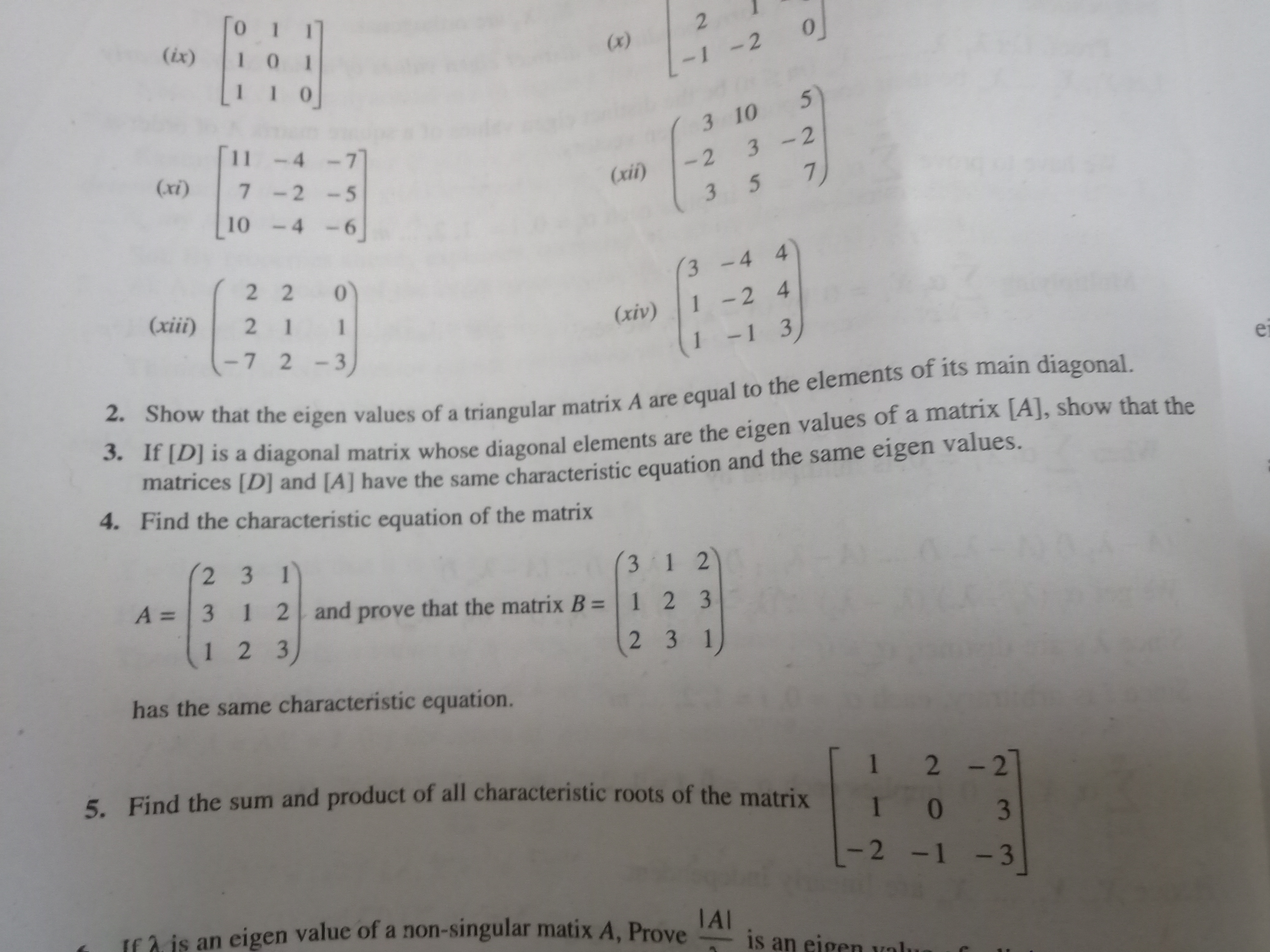Show that the eigen values of a triangular matrix A are equal to the elements of its main diagonal. If D is a diagonal matrix whose diagonal elements are the eigen values of a matr... Show that the eigen values of a triangular matrix A are equal to the elements of its main diagonal. If D is a diagonal matrix whose diagonal elements are the eigen values of a matrix A, show that the matrices D and A have the same characteristic equation and the same eigen values. Find the characteristic equation of the matrix A = [[2, 3, 1], [3, 1, 2], [1, 2, 3]] and prove that the matrix B = [[3, 1, 2], [2, 3, 3], [1, 2, 3]] has the same characteristic equation. Find the sum and product of all characteristic roots of the matrix [[1, 2, -2], [1, 0, 3], [-2, -1, -3]].

Understand the Problem
The question contains various mathematical problems related to eigenvalues and matrices, specifically involving triangular matrices, diagonal matrices, characteristic equations, and operations on matrices.
Answer
The sum of eigenvalues is $-2$, and the product is determined by the characteristic polynomial of matrix $M$.
Answer for screen readers
To determine the eigenvalues of the matrix $M$, we find:
- The characteristic polynomial $p(\lambda) = \text{det}(M - \lambda I) = 0$.
- The sum of the eigenvalues is $-2$ and their product is $\text{det}(M)$.
Steps to Solve
- Eigenvalues of Triangular Matrices
For a triangular matrix, the eigenvalues are the elements on the main diagonal. If we have a triangular matrix $T = \begin{bmatrix} a & b \ 0 & d \end{bmatrix}$, then the eigenvalues are simply $a$ and $d$.
- Characteristic Equation of a Matrix
To find the characteristic equation of a matrix $A$, we compute the determinant of $A - \lambda I$, where $I$ is the identity matrix and $\lambda$ is the eigenvalue. For example, given the matrix:
$$A = \begin{bmatrix} 2 & 3 & 1 \ 3 & 1 & 2 \ 1 & 2 & 3 \end{bmatrix} $$
we need to calculate:
$$\text{det}(A - \lambda I) = 0$$
- Calculating the Determinant
Setting up the matrix $A - \lambda I$:
$$ A - \lambda I = \begin{bmatrix} 2 - \lambda & 3 & 1 \ 3 & 1 - \lambda & 2 \ 1 & 2 & 3 - \lambda \end{bmatrix} $$
Next, compute the determinant using cofactor expansion or row operations.
- Proving the Characteristic Equation of Matrix B
Given another matrix $B$ as:
$$B = \begin{bmatrix} 3 & 1 & 2 \ 1 & 2 & 3 \ 2 & 3 & 1 \end{bmatrix}$$
We perform the same steps to compute the characteristic polynomial:
$$\text{det}(B - \lambda I) = 0$$
- Sum and Product of Eigenvalues
The sum of the eigenvalues of a matrix is equal to the trace of the matrix (sum of diagonal elements), and the product of the eigenvalues is equal to the determinant. For the matrix:
$$M = \begin{bmatrix} 1 & 2 & -2 \ 1 & 0 & 3 \ -2 & -1 & -3 \end{bmatrix}$$
Calculate:
- The sum of eigenvalues: $\text{Tr}(M) = 1 + 0 - 3 = -2$
- The product of eigenvalues: $\text{det}(M)$.
To determine the eigenvalues of the matrix $M$, we find:
- The characteristic polynomial $p(\lambda) = \text{det}(M - \lambda I) = 0$.
- The sum of the eigenvalues is $-2$ and their product is $\text{det}(M)$.
More Information
Eigenvalues are important as they provide insight into the behavior of the matrix transformation, including scaling and rotation properties. This enables analysis in various applications, including stability in differential equations and principal component analysis in statistics.
Tips
- Not calculating the determinant correctly. Ensure proper matrix operations are followed.
- Confusing the trace with the determinant; the trace is the sum of diagonal elements, while the determinant is a product of eigenvalues.
AI-generated content may contain errors. Please verify critical information